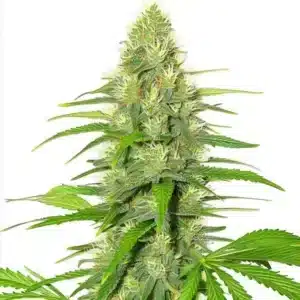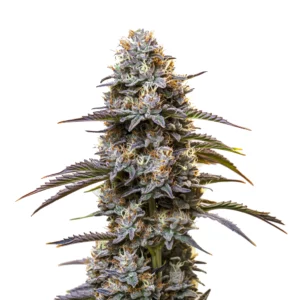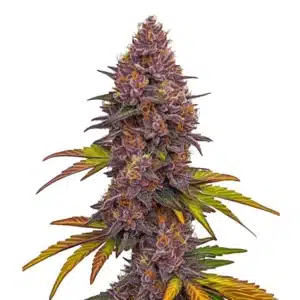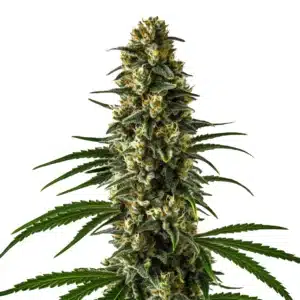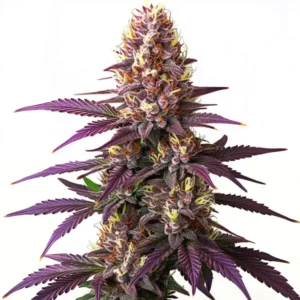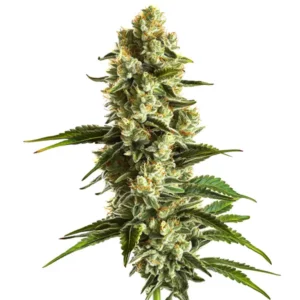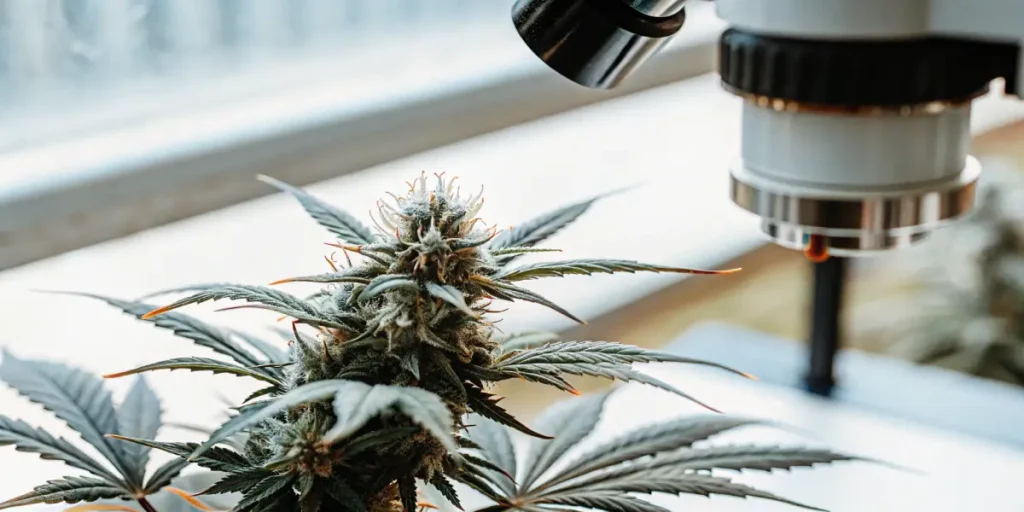
Biochemical Basis of Cannabis Aroma
The biochemical basis of cannabis aroma is a fascinating subject for both first-time cannabis seed buyers and experienced growers. Each cannabis strain has a unique scent profile, largely due to the biochemical pathways cannabis aroma follows. When growing cannabis, the scent is one of the first indicators of a plant’s health and vitality.
The molecular composition of cannabis aroma is complex. It primarily involves terpenes, which produce a vast range of scents. Terpenes are natural compounds found in many plants, but cannabis has a particularly rich terpene profile. These compounds not only define the smell but also influence the experience of cannabis.
Recommended Strains
White Widow
|
|
THC | 18% - 25% (Medium) |
|
|
Type | Feminized |
|
|
Yield | High |
|
|
Phenotype | 45% Indica / 55% Sativa |
Blue Dream
|
|
THC | 17% - 24% (Medium) |
|
|
Type | Feminized |
|
|
Yield | High |
|
|
Phenotype | 50% Indica / 50% Sativa |
For example, the strain Banana Kush is known for its sweet, fruity aroma, which is a direct result of its unique terpene blend. This makes it a popular choice for those who prefer a tropical scent. The terpenes work synergistically with cannabinoids to create an aroma that is both inviting and therapeutic.
Terpenes and Their Role in Cannabis Scent
Terpenes play a crucial role in the cannabis plant’s aroma. These organic compounds are responsible for the diverse scents that range from citrusy and sweet to earthy and pungent. Terpenes such as myrcene, limonene, and pinene are among the most commonly found in cannabis.
Myrcene, for example, gives a musky, earthy scent often associated with classic cannabis. Limonene provides a fresh, citrusy aroma, while pinene offers a sharp, pine-like scent. These terpenes contribute significantly to the overall aroma profile of cannabis and can even impact the effects of the plant.
The biochemical pathways cannabis aroma travels through involve intricate interactions between terpenes and other plant compounds. This complex network of reactions determines how each terpene expresses its scent and how it combines with others to form a complete aroma profile. Understanding these pathways is crucial for breeders and growers who aim to enhance specific aromatic traits.
Furthermore, terpenes role in cannabis scent goes beyond mere aroma. These compounds are also thought to have therapeutic effects, influencing mood and perception. The presence of certain terpenes can amplify the effects of cannabinoids, creating a more holistic experience. This synergy underscores the importance of terpene research in understanding the biochemical basis of cannabis aroma.
Impact of Terpenes on Aroma Profiles
Different strains have varying levels of terpenes, thus affecting their aroma profiles. For instance, Blue Dream, a popular strain, has a high concentration of pinene and myrcene, giving it a sweet yet earthy scent. This aromatic profile is not only pleasant but also has calming effects.
Growers can enhance the terpene profile by optimizing growing conditions. Factors such as light, temperature, and humidity can influence the development of terpenes. By carefully controlling these conditions, growers can amplify the desired aroma characteristics.
One key aspect of the influence of terpenes on aroma profiles is their ability to interact with each other. The combination of different terpenes can lead to nuanced scent profiles that are greater than the sum of their parts. This synergy is part of what makes the cannabis aroma molecular composition so diverse and appealing.
Moreover, terpenes can also impact the perception of aroma strength. Some terpenes may dominate the scent profile, while others add subtle undertones that enhance the overall complexity. This intricate balance highlights the importance of understanding terpenes role in cannabis scent, especially for those aiming to produce strains with specific aromatic qualities.
Promos & Deals
Influence of Cannabinoids on Cannabis Smell
While terpenes are the primary contributors to the scent, cannabinoids also have a subtle influence. Cannabinoids are chemical compounds in cannabis that interact with the body’s endocannabinoid system. THC and CBD are the most well-known cannabinoids, but there are many others.
Each cannabinoid has a distinct influence on the overall aroma and effects of cannabis. For example, strains with higher THC levels often have a more pungent smell. This is because THC can interact with terpenes, enhancing their aromatic properties.
The influence of cannabinoids on cannabis smell is a critical aspect of the plant’s appeal. Although not as aromatic as terpenes, cannabinoids can alter the way scents are perceived by intensifying or mellowing the olfactory experience. This interaction contributes to the complex biochemical basis of cannabis aroma.
Furthermore, cannabinoids can impact the longevity of the aroma. Their interaction with terpenes can affect how long a scent lingers, providing a lasting impression. This dynamic is a crucial consideration for both breeders looking to develop unique strains and consumers seeking a particular aromatic experience. Knowing the influence of cannabinoids on cannabis smell can lead to more targeted cultivation and breeding efforts.

Genetic Factors in Cannabis Aroma Profile
The genetic makeup of a cannabis plant plays a significant role in its aroma profile. Different strains have different genetic codes, which dictate their terpene and cannabinoid production levels. Strains like White Widow have a distinct aroma due to their unique genetic composition.
Breeders select strains based on desired aroma profiles. By cross-breeding plants with high concentrations of specific terpenes and cannabinoids, they can create new strains with unique scents. This selective breeding is why we have such a diverse range of cannabis aromas today.
Genetic factors cannabis aroma profile are crucial for understanding why certain strains have specific scent characteristics. The genetic blueprint of a cannabis plant determines its potential to produce particular terpenes and cannabinoids, ultimately shaping its aroma. This knowledge allows breeders to craft strains with targeted aromatic properties, catering to consumer preferences.
Additionally, genetic diversity within cannabis strains contributes to the wide array of aromas available. This diversity is a result of generations of breeding and selection, where traits such as terpene production and cannabinoid content are prioritized. Understanding these genetic factors is essential for those looking to explore or capitalize on the biochemical pathways cannabis aroma follows, offering new opportunities for innovation in cannabis cultivation.
Practical Tips for Enhancing Cannabis Aroma
Enhancing the aroma of your cannabis plants involves knowing the biochemical pathways cannabis aroma follows. Here are some practical tips to consider during your cultivation process:
- Maintain optimal light exposure, as it can boost terpene production.
- Control temperature and humidity to prevent terpene loss.
- Implement proper drying and curing techniques to preserve aroma.
- Select strains with high terpene profiles for stronger scents.
- Use organic nutrients to enhance natural terpene development.
By following these tips, you can maximize the aromatic potential of your cannabis plants. The right conditions and care can lead to a more intense and enjoyable aroma, enhancing the overall cannabis experience.
Besides to environmental factors, the choice of growing medium can also influence terpene production. Soil rich in organic matter can enhance the natural development of terpenes, contributing to a more vibrant aroma. Experimenting with different growing mediums may yield surprising results in scent enhancement.
Moreover, the timing of harvest plays a crucial role in aroma preservation. Harvesting at peak terpene production ensures that the full aromatic potential of the plant is realized. This attention to detail during the cultivation process highlights the importance of understanding the biochemical basis of cannabis aroma for achieving superior results.
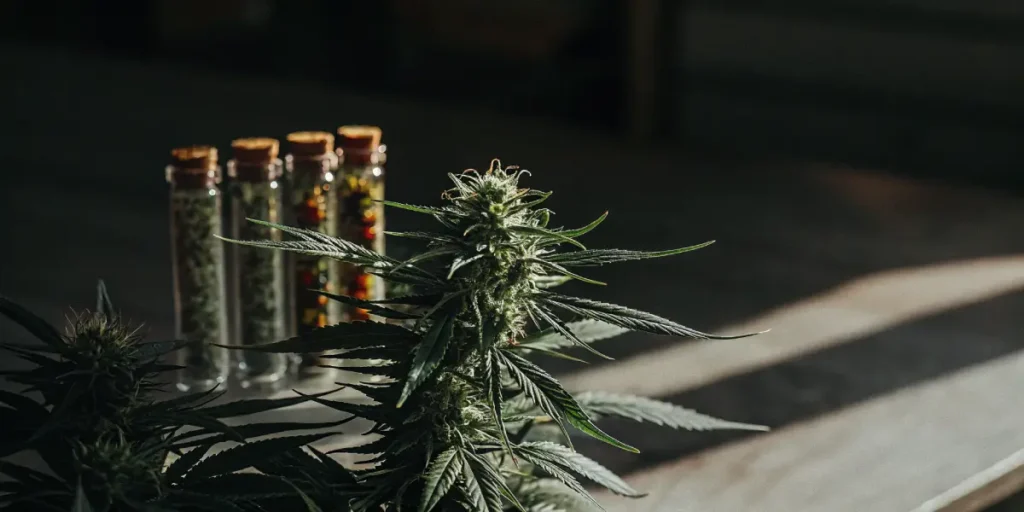
FAQs
What are terpenes and why are they important?
Terpenes are organic compounds that give cannabis its distinctive scent. They are found in the essential oils of many plants and contribute to the aroma and flavor profile. In cannabis, terpenes play a crucial role in the biochemical basis of cannabis aroma, affecting not only smell but also the effects experienced.
For instance, limonene gives a citrusy aroma and can enhance mood, while myrcene has an earthy scent and may promote relaxation. Understanding terpenes helps growers and users appreciate the complexity of cannabis scents and their impact on personal experience.
Terpenes role in cannabis scent extends beyond their aromatic contributions. They are believed to interact with other compounds in the plant, potentially enhancing or modifying the effects of cannabinoids. This interaction is an essential element of the overall cannabis experience, emphasizing the need for a deeper understanding of terpenes and their functions.
Additionally, terpenes are important for the plant’s own survival. They can act as natural deterrents to pests and help protect against environmental stressors. This protective role, combined with their aromatic qualities, makes terpenes indispensable to the cannabis plant’s biology and cultivation.
How do cannabinoids influence cannabis smell?
Cannabinoids, while not as aromatic as terpenes, do have a role in the aroma profile. These compounds, like THC and CBD, can interact with terpenes to modify the scent and overall effect of the cannabis. Strains with higher THC levels might have a more pronounced smell due to this interaction.
This interaction is part of what makes each cannabis strain unique. Cannabinoids can enhance the scent profile by amplifying the effects of terpenes, making them more potent and noticeable to the senses.
The influence of cannabinoids on cannabis smell can also vary based on the specific cannabinoid profile of a strain. For instance, the presence of lesser-known cannabinoids, such as CBG or CBN, might subtly alter the scent by affecting terpene expression or stability. This complexity adds another layer to the understanding of cannabis aroma molecular composition.
Furthermore, the biochemical pathways cannabis aroma follows are influenced by the interplay between cannabinoids and terpenes. This interaction can result in unexpected scent profiles, highlighting the intricate nature of cannabis biology. By exploring these pathways, researchers and cultivators can unlock new aromatic possibilities.
What genetic factors affect cannabis aroma?
The genetic makeup of a cannabis plant dictates its terpene and cannabinoid production, which in turn affects its aroma. Different strains have unique genetic codes that result in varying scent profiles. Selective breeding has led to a wide variety of aromas available today.
Growers often choose strains based on these genetic traits to produce desired aromas. For example, strains with a higher concentration of pinene will have a pine-like scent, while those with more limonene will smell citrusy.
Genetic factors cannabis aroma profile are crucial in developing strains with specific aromatic qualities. By understanding the hereditary components that influence terpene and cannabinoid levels, breeders can create plants that consistently produce the desired scents. This precision breeding is a testament to the sophistication of modern cannabis cultivation techniques.
Moreover, advances in genetic research have made it possible to map the genes responsible for terpene and cannabinoid production. This knowledge allows for more targeted breeding programs, ensuring that the biochemical pathways cannabis aroma follows are optimized for aroma enhancement. This scientific approach is paving the way for new and exciting developments in cannabis aroma profiles.
How can I enhance the aroma of my cannabis plants?
To enhance the aroma, focus on optimizing your growing conditions. Ensure proper lighting, temperature, and humidity to boost terpene production. Use organic nutrients and follow correct drying and curing practices to preserve and enhance the scent.
Selecting strains with naturally high terpene profiles is also crucial. By choosing the right seeds and providing optimal care, you can cultivate cannabis with a more intense and appealing aroma.
Incorporating natural supplements into your cultivation routine can also aid in enhancing aroma. Products rich in carbohydrates and amino acids can stimulate terpene production, reinforcing the plant’s natural scent profile. This approach aligns with the biochemical basis of cannabis aroma, focusing on natural enhancement strategies.
Additionally, monitoring the plant’s life cycle and making adjustments at different growth stages can optimize aroma development. Attention to detail, from seedling to harvest, ensures that the biochemical pathways cannabis aroma follows are respected, leading to a superior aromatic outcome. This comprehensive approach combines scientific knowledge with practical cultivation techniques for the best results.
What strains are known for their strong aroma?
Several strains are celebrated for their strong, distinctive aromas. Banana Kush is known for its sweet, tropical scent, while Blue Dream offers a sweet, earthy aroma. These strains are popular among growers who prioritize a rich aromatic profile.
Another notable strain is White Widow, which features a pungent yet pleasant scent. Choosing these strains can ensure a flavorful and aromatic cannabis experience, making them ideal for both personal enjoyment and cultivation.
Strains like Sour Diesel and OG Kush are also renowned for their potent aromas. Sour Diesel is famous for its pungent, fuel-like scent, whereas OG Kush combines earthy and pine notes with a hint of lemon. These strains exemplify the diverse genetic factors cannabis aroma profile possesses, offering a wide range of sensory experiences.
Furthermore, newer strains are continually being developed with unique aromatic properties. Innovations in breeding have led to hybrids that combine the best of both parent strains, resulting in novel scent profiles. This ongoing exploration of cannabis aroma molecular composition ensures that enthusiasts always have something new to discover.


